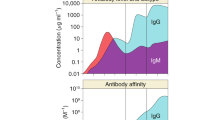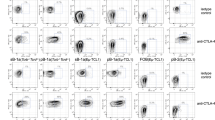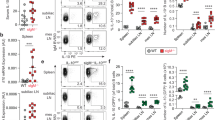Abstract
Mature B cells express immunoglobulin M (IgM)- and IgD-isotype B cell antigen receptors, but the importance of IgD for B cell function has been unclear. By using a cellular in vitro system and corresponding mouse models, we found that antigens with low valence activated IgM receptors but failed to trigger IgD signaling, whereas polyvalent antigens activated both receptor types. Investigations of the molecular mechanism showed that deletion of the IgD-specific hinge region rendered IgD responsive to monovalent antigen, whereas transferring the hinge to IgM resulted in responsiveness only to polyvalent antigen. Our data suggest that the increased IgD/IgM ratio on conventional B-2 cells is important for preferential immune responses to antigens in immune complexes, and that the increased IgM expression on B-1 cells is essential for B-1 cell homeostasis and function.
This is a preview of subscription content, access via your institution
Access options
Subscribe to this journal
Receive 12 print issues and online access
$209.00 per year
only $17.42 per issue
Buy this article
- Purchase on Springer Link
- Instant access to full article PDF
Prices may be subject to local taxes which are calculated during checkout







Similar content being viewed by others
Change history
21 May 2015
In the version of this article initially published, the bottom left plot in Figure 3c, the top right plot in Figure 4a, and the third and bottom plots in the left column of Figure 6a were duplicates of other plots in the same figure. Those plots have been replaced and the errors have been corrected in the HTML and PDF versions of the article.
References
Lam, K.P., Kuhn, R. & Rajewsky, K. In vivo ablation of surface immunoglobulin on mature B cells by inducible gene targeting results in rapid cell death. Cell 90, 1073–1083 (1997).
Pillai, S., Cariappa, A. & Moran, S.T. Positive selection and lineage commitment during peripheral B-lymphocyte development. Immunol. Rev. 197, 206–218 (2004).
Schatz, D.G., Oettinger, M.A. & Schlissel, M.S. V(D)J recombination: molecular biology and regulation. Annu. Rev. Immunol. 10, 359–383 (1992).
Nemazee, D. & Weigert, M. Revising B cell receptors. J. Exp. Med. 191, 1813–1817 (2000).
Tisch, R., Roifman, C.M. & Hozumi, N. Functional differences between immunoglobulins M and D expressed on the surface of an immature B-cell line. Proc. Natl. Acad. Sci. USA 85, 6914–6918 (1988).
Avrameas, S., Hosli, P., Stanislawski, M., Rodrigot, M. & Vogt, E. A quantitative study at the single cell level of immunoglobulin antigenic determinants present on the surface of murine B and T lymphocytes. J. Immunol. 122, 648–659 (1979).
Kim, K.M. & Reth, M. Signaling difference between class IgM and IgD antigen receptors. Ann. NY Acad. Sci. 766, 81–88 (1995).
Carsetti, R., Kohler, G. & Lamers, M.C. A role for immunoglobulin D: interference with tolerance induction. Eur. J. Immunol. 23, 168–178 (1993).
Mayumi, M. et al. Positive and negative signals transduced through surface immunoglobulins in human B cells. J. Allergy Clin. Immunol. 94, 612–619 (1994).
Goodnow, C.C. et al. Altered immunoglobulin expression and functional silencing of self-reactive B lymphocytes in transgenic mice. Nature 334, 676–682 (1988).
Cooke, M.P. et al. Immunoglobulin signal transduction guides the specificity of B cell-T cell interactions and is blocked in tolerant self-reactive B cells. J. Exp. Med. 179, 425–438 (1994).
Goodnow, C.C., Brink, R. & Adams, E. Breakdown of self-tolerance in anergic B lymphocytes. Nature 352, 532–536 (1991).
Förster, I. & Rajewsky, K. Expansion and functional activity of Ly-1+ B cells upon transfer of peritoneal cells into allotype-congenic, newborn mice. Eur. J. Immunol. 17, 521–528 (1987).
Pennell, C.A. et al. Biased immunoglobulin variable region gene expression by Ly-1 B cells due to clonal selection. Eur. J. Immunol. 19, 1289–1295 (1989).
Gu, H., Forster, I. & Rajewsky, K. Sequence homologies, N sequence insertion and JH gene utilization in VHDJH joining: implications for the joining mechanism and the ontogenetic timing of Ly1 B cell and B-CLL progenitor generation. EMBO J. 9, 2133–2140 (1990).
Tsiantoulas, D., Gruber, S. & Binder, C.J. B-1 cell immunoglobulin directed against oxidation-specific epitopes. Front. Immunol. 3, 415 (2012).
Hayakawa, K. et al. Ly-1 B cells: functionally distinct lymphocytes that secrete IgM autoantibodies. Proc. Natl. Acad. Sci. USA 81, 2494–2498 (1984).
Fruman, D.A. et al. Impaired B cell development and proliferation in absence of phosphoinositide 3-kinase p85α. Science 283, 393–397 (1999).
Khan, W.N. et al. Defective B cell development and function in Btk-deficient mice. Immunity 3, 283–299 (1995).
Hayakawa, K. et al. Positive selection of natural autoreactive B cells. Science 285, 113–116 (1999).
O'Keefe, T.L., Williams, G.T., Davies, S.L. & Neuberger, M.S. Hyperresponsive B cells in CD22-deficient mice. Science 274, 798–801 (1996).
Casola, S. et al. B cell receptor signal strength determines B cell fate. Nat. Immunol. 5, 317–327 (2004).
Meixlsperger, S. et al. Conventional light chains inhibit the autonomous signaling capacity of the B cell receptor. Immunity 26, 323–333 (2007).
Reth, M., Hammerling, G.J. & Rajewsky, K. Analysis of the repertoire of anti-NP antibodies in C57BL/6 mice by cell fusion. I. Characterization of antibody families in the primary and hyperimmune response. Eur. J. Immunol. 8, 393–400 (1978).
Roes, J. & Rajewsky, K. Immunoglobulin D (IgD)-deficient mice reveal an auxiliary receptor function for IgD in antigen-mediated recruitment of B cells. J. Exp. Med. 177, 45–55 (1993).
Nezlin, R. Internal movements in immunoglobulin molecules. Adv. Immunol. 48, 1–40 (1990).
Huang, F. & Nau, W.M. A conformational flexibility scale for amino acids in peptides. Angew. Chem. Int. Ed. Engl. 42, 2269–2272 (2003).
Lutz, C. et al. IgD can largely substitute for loss of IgM function in B cells. Nature 393, 797–801 (1998).
Nitschke, L., Kosco, M.H., Kohler, G. & Lamers, M.C. Immunoglobulin D-deficient mice can mount normal immune responses to thymus-independent and -dependent antigens. Proc. Natl. Acad. Sci. USA 90, 1887–1891 (1993).
Chou, M.Y. et al. Oxidation-specific epitopes are dominant targets of innate natural antibodies in mice and humans. J. Clin. Invest. 119, 1335–1349 (2009).
Brink, R. et al. Immunoglobulin M and D antigen receptors are both capable of mediating B lymphocyte activation, deletion, or anergy after interaction with specific antigen. J. Exp. Med. 176, 991–1005 (1992).
Zikherman, J., Parameswaran, R. & Weiss, A. Endogenous antigen tunes the responsiveness of naive B cells but not T cells. Nature 489, 160–164 (2012).
Batista, F.D., Iber, D. & Neuberger, M.S. B cells acquire antigen from target cells after synapse formation. Nature 411, 489–494 (2001).
Kosco-Vilbois, M.H., Gray, D., Scheidegger, D. & Julius, M. Follicular dendritic cells help resting B cells to become effective antigen-presenting cells: induction of B7/BB1 and upregulation of major histocompatibility complex class II molecules. J. Exp. Med. 178, 2055–2066 (1993).
Kim, Y.M. et al. Monovalent ligation of the B cell receptor induces receptor activation but fails to promote antigen presentation. Proc. Natl. Acad. Sci. USA 103, 3327–3332 (2006).
Yang, J. & Reth, M. Oligomeric organization of the B-cell antigen receptor on resting cells. Nature 467, 465–469 (2010).
Klasener, K., Maity, P.C., Hobeika, E., Yang, J. & Reth, M. B cell activation involves nanoscale receptor reorganizations and inside-out signaling by Syk. Elife 3, e02069 (2014).
Allen, D., Simon, T., Sablitzky, F., Rajewsky, K. & Cumano, A. Antibody engineering for the analysis of affinity maturation of an anti-hapten response. EMBO J. 7, 1995–2001 (1988).
Lavoie, T.B., Drohan, W.N. & Smith-Gill, S.J. Experimental analysis by site-directed mutagenesis of somatic mutation effects on affinity and fine specificity in antibodies specific for lysozyme. J. Immunol. 148, 503–513 (1992).
Mouquet, H. et al. Polyreactivity increases the apparent affinity of anti-HIV antibodies by heteroligation. Nature 467, 591–595 (2010).
Krogsgaard, M. et al. Agonist/endogenous peptide-MHC heterodimers drive T cell activation and sensitivity. Nature 434, 238–243 (2005).
Shinall, S.M., Gonzalez-Fernandez, M., Noelle, R.J. & Waldschmidt, T.J. Identification of murine germinal center B cell subsets defined by the expression of surface isotypes and differentiation antigens. J. Immunol. 164, 5729–5738 (2000).
Tiller, T. et al. Autoreactivity in human IgG+ memory B cells. Immunity 26, 205–213 (2007).
Boes, M. et al. Accelerated development of IgG autoantibodies and autoimmune disease in the absence of secreted IgM. Proc. Natl. Acad. Sci. USA 97, 1184–1189 (2000).
Binder, C.J. et al. Pneumococcal vaccination decreases atherosclerotic lesion formation: molecular mimicry between Streptococcus pneumoniae and oxidized LDL. Nat. Med. 9, 736–743 (2003).
Köhler, F. et al. Autoreactive B cell receptors mimic autonomous pre-B cell receptor signaling and induce proliferation of early B cells. Immunity 29, 912–921 (2008).
Onufriev, A., Bashford, D. & Case, D.A. Exploring protein native states and large-scale conformational changes with a modified generalized born model. Proteins 55, 383–394 (2004).
Cornell, W.D. et al. A second generation force field for the simulation of proteins, nucleic acids, and organic molecules. J. Am. Chem. Soc. 117, 5179–5197 (1995).
Hornak, V. et al. Comparison of multiple amber force fields and development of improved protein backbone parameters. Proteins 65, 712–725 (2006).
Humphrey, W., Dalke, A. & Schulten, K. VMD: visual molecular dynamics. J. Mol. Graph. 14, 33–38 (1996).
Acknowledgements
We thank P. Nielsen for scientific discussion and critical reading of the manuscript; U. Stauffer, N. Joswig and C. Johner for mouse work; A. Würch and M. Knoblauch for help with flow cytometry experiments; H.-P. Pircher (University of Freiburg) and A. Weiss (University of California, San Francisco) for providing MD4 and ML5 mice, respectively; and F.D. Batista (London Research Institute) for providing cDNA encoding for immunoglobulin HC and LC genes of the HH10 BCR. This work was supported by the Deutsche Forschungsgemeinschaft (JU 463/2-1 and TRR130) and the Deutsche Krebshilfe (Project 108935).
Author information
Authors and Affiliations
Contributions
R.Ü. performed experiments, analyzed data and contributed to the design of experiments and the writing of the manuscript; E.H., M.P.B. and T.W. performed experiments and analyzed data; A.H.C.H. and H.S. performed the molecular dynamics simulations and, together with M.D.-v.M., modeled the IgD and IgM BCR variants; K.K. and T.K. contributed to the characterization of the hinge region; D.T. and C.J.B. tested the sera from wild-type and IgM-null mice; L.N. generated the IgD-null mice; M.R. gave advice for the experiments on HH10 and B1-8 BCRs; and H.J. designed the study, supervised the work and wrote the manuscript.
Corresponding author
Ethics declarations
Competing interests
The authors declare no competing financial interests.
Integrated supplementary information
Supplementary Figure 1 B1-8 and HH10 BCRs specifically recognize the cognate antigens.
(a) Flow cytometry analysis shows specific binding of the cognate antigens for cYFP+ triple-deficient cells expressing the indicated
constructs. (b) Cells from a were subjected to calcium measurement. After a 1-min baseline recording, cells were stimulated with
the indicated molecules. (c) The Coomassie gel shows crosslinking of HEL by incubation with the indicated concentration of
glutaraldehyde (GA) for 48 h at room temperature. Results are representative of at least three independent experiments.
Supplementary Figure 2 IgM-BCR induces AKT phosphorylation in response to soluble HEL.
Triple-deficient cells expressing the indicated constructs were treated with s-HEL or c-HEL for various periods of time, fixed, permeabilized and stained for intracellular phosphorylated AKT with specific immunofluorescent antibodies. Representative results of one out of two independent experiments are shown.
Supplementary Figure 3 Structural properties of the linker sequences investigated.
For each linker an overlay of ten representative conformations sampled over the simulation time is shown (generated by
superposition of the N-terminal residues). (a) SG5. (b) SG10. (c) SG17. (d) p34.
Supplementary Figure 4 Western blot analysis under non-reducing conditions of triple-deficient cells expressing the indicated constructs.
The BCR variants were detected using anti-κ light chain antibodies. Actin served as a loading control. Results are representative of two independent experiments.
Supplementary Figure 5 The IgD hinge confers unresponsiveness toward low-valence antigens.
(a) Schematic representation of the different IgD-BCR variants. (b,c) Flow cytometric analyses of cYFP+ triple-deficient cells show
(b) BCR surface expression and (c) specific binding of NIP(2)-peptide. (d) Triple-deficient cells from b and c were subjected to calcium
measurement. After a 1-min baseline recording, cells were stimulated with 2 μM OHT and 10 nM NIP(2)-peptide or NIP(7)-BSA. Results are
representative of at least three independent experiments. (e) Statistical analysis of calcium flux experiments of TKO cells expressing the
indicated BCRs and stimulated with the indicated antigens. Shown is the mean calcium flux peak over the mean baseline signal of four
independent experiments (n=4, mean ± SEM). P values were calculated using Student’s t-test.
Supplementary Figure 6 Proposed model of the respective BCR types with or without antigen.
Whereas (a) monomeric s-HEL is bound by a single IgD molecule through a high-affinity interaction with the
cognate epitope and, presumably, a second non-specific epitope on the same HEL protein, (b) ic4-HEL
complexes lead to efficient ligation of multiple IgD molecules. (c) Low-valence antigens such as NIP(2)-peptide can stably ligate two
rigid IgM BCR molecules, whereas ligation of multiple IgD BCRs requires polyvalent antigen.
Supplementary Figure 7 Soluble low-valence antigens inhibit IgD activation by polyvalent antigens.
(a) Triple-deficient cells expressing either HH10 IgM or the IgD BCR were subjected to calcium measurement. After a 1-min baseline
recording, cells were stimulated with streptavidin-crosslinked HEL-biotin (c-HEL) supplemented with the indicated amounts of soluble
HEL or BSA. Data are representative of four independent experiments. (b) Statistical analysis of the experiment depicted
in a. Shown is the mean calcium flux peak over the mean baseline signal of four independent experiments (n = 4, mean ± s.e.m.).
(c) Shown is a calcium flux experiment using freshly isolated CD43− splenic B cells from MD4 and MD4 × ML5 mice,
before and after administration of the indicated stimuli. Calcium measurements are representative of at least three independent
experiments. (d) Statistical analysis of the experiment depicted in c. Shown is the mean calcium flux peak over the mean baseline
signal of three independent experiments (n = 3, mean ± s.e.m.). P values were calculated using Student’s t-test.
Supplementary Figure 8 IgD-null mice exhibit markedly increased quantities of peritoneal-cavity B-1a cells.
Statistical analysis of flow cytometry stainings with cells isolated from the peritoneal cavities of wild-type and IgD-null mice. Gated for CD19+Mac-1+CD5+ (B-1a), CD19+Mac-1+CD5– (B-1b) and CD19+Mac-1–CD5– (B-2) cells (n = 4 mice per genotype of at least two independent experiments; mean ± s.e.m.). P values were calculated using Student’s t-test.
Supplementary Figure 9 B1a cell–derived BCR induces B cell proliferation when expressed as IgM but not IgD.
(a) Histograms of a representative measurement out of four experiments showing enrichment of triple-deficient cells expressing IgM
and IgD variants of a B-1a cell–derived BCR. The percentage of cYFP+ cells was assessed at day 1 and day 4 after transduction.
(b) A summary of four independent experiments (mean ± s.e.m.). P values were calculated using Student’s t-test.
Supplementary information
Supplementary Text and Figures
Supplementary Figures 1–9 (PDF 542 kb)
Rights and permissions
About this article
Cite this article
Übelhart, R., Hug, E., Bach, M. et al. Responsiveness of B cells is regulated by the hinge region of IgD. Nat Immunol 16, 534–543 (2015). https://doi.org/10.1038/ni.3141
Received:
Accepted:
Published:
Issue Date:
DOI: https://doi.org/10.1038/ni.3141
This article is cited by
-
A nanoparticle vaccine displaying the ookinete PSOP25 antigen elicits transmission-blocking antibody response against Plasmodium berghei
Parasites & Vectors (2023)
-
Molecular basis for potent B cell responses to antigen displayed on particles of viral size
Nature Immunology (2023)
-
B-cell receptor physical properties affect relative IgG1 and IgE responses in mouse egg allergy
Mucosal Immunology (2022)
-
Avidity in antibody effector functions and biotherapeutic drug design
Nature Reviews Drug Discovery (2022)
-
Protein-based antigen presentation platforms for nanoparticle vaccines
npj Vaccines (2021)



